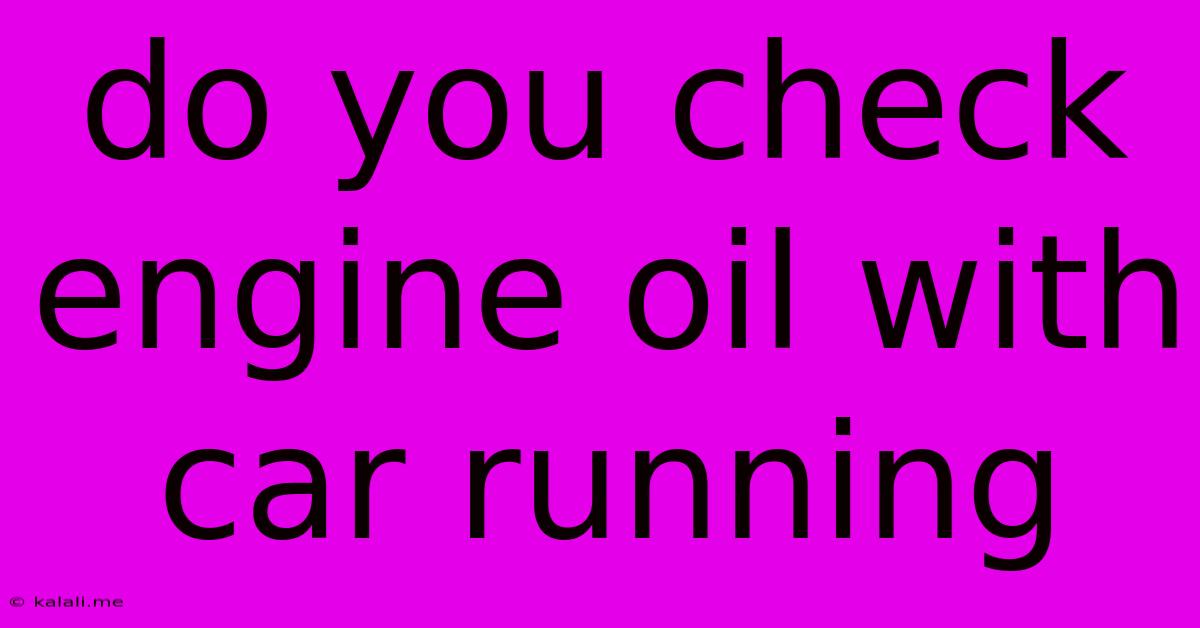Do You Check Engine Oil With Car Running
Kalali
Jun 11, 2025 · 3 min read

Table of Contents
Should You Check Engine Oil with Your Car Running? A Definitive Guide
Checking your engine oil is a crucial part of car maintenance, ensuring your engine remains lubricated and runs smoothly. But there's a common question among drivers: should you check your engine oil with the car running? The short answer is a resounding no. Checking your oil while the engine is running is dangerous and inaccurate. This article will explain why and guide you through the proper procedure for checking your engine oil level.
Why Checking Oil with the Engine Running is Dangerous and Inaccurate:
- Risk of Burns: Hot engine oil can cause serious burns. Even a slight spill can result in painful injuries.
- Inaccurate Readings: The oil pressure system is active while the engine is running, which means the oil isn't settling properly in the sump. This makes getting an accurate reading nearly impossible. The level you see will be significantly lower than the actual level.
- Moving Parts: Working around a running engine presents a significant risk of accidental injury from moving parts.
- Spillage: The increased pressure within the system when the engine is running increases the risk of oil spillage and mess.
The Correct Way to Check Your Engine Oil:
-
Safety First: Ensure your car is parked on a level surface, the engine is completely off, and the parking brake is engaged. Allow the engine to cool down for at least 15-20 minutes after driving. This allows the oil to settle back into the oil pan for an accurate reading.
-
Locate the Dipstick: Your dipstick is usually located near the engine, often marked with an oil can symbol. Consult your owner's manual if you're unsure of its location.
-
Remove and Wipe the Dipstick: Carefully remove the dipstick, wiping it clean with a lint-free cloth or paper towel.
-
Reinsert and Remove Again: Fully reinsert the dipstick back into its tube and remove it again.
-
Check the Oil Level: The dipstick will have markings indicating the minimum and maximum oil levels. The oil level should ideally be between these two marks. If the oil level is low, you'll need to add more oil. Always use the type and grade of oil recommended in your owner's manual.
-
Add Oil (if necessary): If the oil level is low, carefully add the recommended oil using a funnel. Avoid overfilling, as this can be just as harmful as low oil levels. Recheck the level after adding oil to ensure it's within the acceptable range.
Understanding Engine Oil and its Importance:
Engine oil is vital for your engine's health. It lubricates moving parts, reducing friction and wear, preventing overheating, and cleaning away contaminants. Regular oil changes and monitoring the oil level are essential for maintaining optimal engine performance and longevity. Ignoring low oil levels can lead to serious engine damage and costly repairs. Regularly checking your oil, using the correct method, is a simple yet crucial step in proactive car maintenance.
Understanding Low Oil Levels and Their Consequences:
Low oil levels can lead to several issues, including:
- Reduced engine lubrication: Leading to increased wear and tear on engine components.
- Engine overheating: Lack of lubrication can cause excessive heat buildup, potentially damaging or seizing the engine.
- Engine damage: Severe low oil levels can cause catastrophic engine failure, requiring extensive repairs or replacement.
By following these steps and avoiding the dangerous practice of checking your oil with the engine running, you'll ensure your vehicle's long-term health and your personal safety. Remember to always consult your owner's manual for specific instructions related to your car model.
Latest Posts
Latest Posts
-
Moment Of Inertia Of A Rectangular Plate
Jun 12, 2025
-
Which Of The Following Is Not A Conductor Of Electricity
Jun 12, 2025
-
Shapes With 1 Line Of Symmetry
Jun 12, 2025
-
The First Psychological Laboratory Was Established By
Jun 12, 2025
-
Which Is Not A Greenhouse Gas
Jun 12, 2025
Related Post
Thank you for visiting our website which covers about Do You Check Engine Oil With Car Running . We hope the information provided has been useful to you. Feel free to contact us if you have any questions or need further assistance. See you next time and don't miss to bookmark.